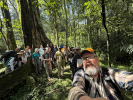Astroparticle physics
Next chapters on neutrino science
April 5, 2023
Share
![The 12-metre diameter acrylic SNO+ detector is filled with 780 tonnes of liquid scintillator and surrounded by 10,000 photomultiplier light detectors. [Credit: Dr. Alex Wright for the SNO+ Collaboration, Queen's Art of Research]](/gazette/sites/gazettewww/files/styles/xsjpg1x3to2/public/2023-12/SNOLAB%20Blue%20detector%20NEW_0.jpg?itok=WABcJb4m)
The 12-metre diameter acrylic SNO+ detector is filled with 780 tonnes of liquid scintillator and surrounded by 10,000 photomultiplier light detectors. (Credit: Dr. Alex Wright for the SNO+ Collaboration, Queen's Art of Research)
Following up on groundbreaking discoveries in astroparticle physics, the Sudbury Neutrino Observatory (SNO), now part of SNOLAB, is moving on to a new phase. SNO+ officially just started running in 2022, but has already published exciting results. While filled with water during the transition period between SNO and SNO+, it detected signals from antineutrinos produced in nuclear reactors situated hundreds of kilometres away.
Built in the 1990s, SNO is located in the Creighton mine in Sudbury, and was the setting for Nobel-winning research by Queen’s professor Arthur McDonald that showed that neutrinos have mass and change their type while travelling through the universe. Later, the SNO laboratory evolved to include new experiments and became SNOLAB, the deepest cleanest lab in the world, dedicated to research on neutrinos and dark matter.
Neutrinos are subatomic particles – just like electrons. However, because they have no electrical charge and very little mass, they hardly interact with matter, making neutrinos very hard to spot, even though they are abundant in the universe, including right here on Earth.
The original SNO experiment was built to address the challenge of observing neutrinos. Situated 2 km underground, it is protected from radiation and other interferences. The equipment consisted of a massive acrylic spheric vessel full of heavy water – denser than regular water and commonly used in nuclear reactors – surrounded by thousands of very sensitive light detectors. The experiment successfully detected neutrinos originating in the core of the sun and that constantly bombard Earth.
In 2018, SNO developed into SNO+. Instead of heavy water, SNO+ now uses a liquid scintillator (a substance that emits light when interacting with radiation) to detect neutrinos. But for a period of time, while the equipment was being upgraded, the vessel was filled with regular pure water. And that was when the team saw something exciting happen: SNO+ detected antineutrinos (the antimatter version of neutrinos) produced by nuclear reactors situated hundreds of kilometres away, in the Bruce, Darlington, and Pickering generating stations.
This was the first time such a signal was detected by a water-based detector. The findings, published in Physical Review Letters, demonstrate that it is feasible to build antineutrino detectors using water – an inexpensive, easy-to-handle material – to monitor nuclear reactors.
![Dr. Peter Skensved is the only person to ever access the top of the acrylic SNO+ detector in order to perform a small modification to its surface. [Credit: Dr. Mark Chen]](/gazette/sites/gazettewww/files/styles/xsjpg1x3to2/public/2023-12/Peter%20Skensved.jpg?itok=1OLc24UE)
Dr. Peter Skensved is the only person to ever access the top of the acrylic SNO+ detector in order to perform a small modification to its surface. (Credit: Dr. Mark Chen)
“To be able to remotely monitor nuclear reactors by observing the antineutrinos they produce has long been a goal of researchers aiming to apply neutrino technology to nuclear non-proliferation,” says SNO+ director Mark Chen, Gordon and Patricia Gray Chair professor at Queen’s Department of Physics, Engineering Physics and Astronomy. “In addition to providing a new option for those developing reactor monitoring technology, this result also shows that our detector is functioning very well and makes us excited for the next phase of the experiment.”
The recently published study demonstrates the sensitivity of SNO+ to antineutrinos from distant nuclear generating stations, a feature that will be exploited with the detector filled with liquid scintillator.
“Our plan is to make new and precise measurements of how neutrinos change their type as they propagate, further elucidating the phenomenon discovered in the original SNO experiment,” explains Alex Wright, IPP Research Scientist and also a member of SNO+ and Queen’s Department of Physics, Engineering Physics and Astronomy.
The future of SNO+
Since 2022, SNO+ has been up and running, filled with liquid scintillator. The next rare phenomenon scientists hope to observe is neutrinoless double beta decay, a rare radioactive decay that emits no neutrinos.
Usually, when atomic nuclei undergo fusion in the core of the sun, neutrinos are a byproduct of that reaction. Similarly, in nuclear reactors, antineutrinos are produced in beta decay, that is, the breakdown of a neutron in an atomic nucleus into a proton, an electron, and an antineutrino.
However, in neutrinoless double beta decay – up to this day, a theoretical possibility – two neutrons in an atom’s nucleus change into two protons and two electrons, but no neutrinos or antineutrinos. This can only happen if the double decay creates both particle and antiparticle, which would virtually annihilate each other.
If neutrinoless double beta decay is observed, it will therefore prove that neutrinos are their own antiparticles.
“This would have great implications to our understanding of neutrinos; in particular, how they came to have very small but non-zero masses,” says Dr. Wright. “It might even help us to explain one of the great mysteries of the Universe – how there came to be more matter than antimatter and, hence, how we can exist.”



